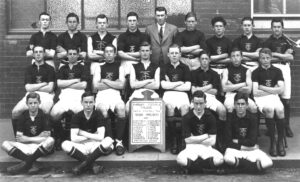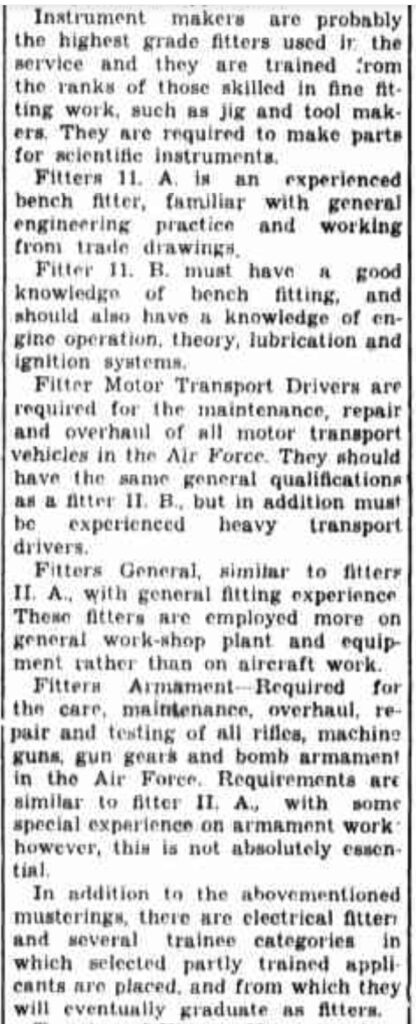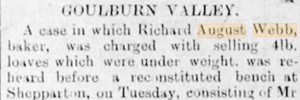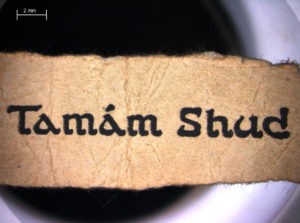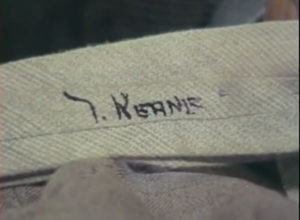When Derek Abbott first named Carl Webb as the Somerton Man, he noted that his brother-in-law was Gerald Thomas Keane, and speculated that the “J/T Kean[e]”-named clothes in the Somerton Man’s suitcase might have belonged to him. I immediately pointed out that Gerald Keane was known as “Gerald Keane” (rather than “Thomas Keane”), and wondered – hopefully more usefully – whether the Keane in question might have been John Russell “Jack” Keane, Gerald Keane’s son, who died in an air accident in 1943. I also – rather more specifically – speculated whether the Somerton Man’s suitcase might actually have been Jack Keane’s suitcase.
In that vein, I threw some money at NAA to get Jack Keane’s 129-page service record digitised: which finally came online yesterday.
Meet Jack Keane
Born 3rd September 1917 in Camperdown, Victoria, son of Gerald Keane (“Theatre Employee”, of 194 Stewart St, Brunswick East), John Russell Keane was educated after 12 at St Monica’s, Wingfield St, Footscray from 1929 to 1931 (p.128), passing his Christian Brothers Scholarship exams in Maths, History, Geography and English in 1930. His occupation since school was as an electrical fitter’s assistant (Radio Service, 3 years), and then as a Motor Mechanic (Lanes Motors, Dorcas Street, South Melbourne, 18 months). He had a single traffic offence (fined £2).
Prior to enrolling in the RAAF Reserve in 1941, he had had two 30-minutes instructional flights in a dual-control plane (courtesy of Essendon Aero Club), plus 3 months “Universal (military) Training” with 8th Field Regiment. His 1934 character reference was from Charles Williams of Amalgamated Wireless Australasia (AWA), who had known him “since his childhood days” (p.126). His 1940 character reference was from A. A. Howitt of 156 Toorak Road, South Yarra, who had known “Jack Keane for many years and [had] every confidence in his ability and integrity” (p.124).
So, here’s Jack Keane (p.68):
Training in the RAAF
Though not initially assessed as being commissioning officer material, Jack Keane did extremely well in training, finishing top in his class of 62 pilots. His instructors’ assessments were all “average” or “above average”, with the only occasional note of caution being a tendency towards “overconfidence” (this appears multiple times). It’s true that one particular training session was assessed as “bloody awful”, but everyone can have an off day, right?
There’s a nice picture of him in his training notes (p.36):
Though admittedly his next photo is a bit more scowly:
His RAAF timeline looks something like this:
- 10 Oct 1941 – 4 I.T.S. (Victor Harbour)
- 31 Jan 1942 – 5 days’ leave
- 05 Feb 1942 – No. 3 E.F.T.S Essendon
- 20 Apr 1942 – No. 11 E.F.T.S Bonalla
- Embarked Sydney 9/8/1942
- Disembarked Canada 2/9/1942
- 02 Sep 1942 – No. 3 “M” Depot Edmonton
- 27 Sep 1942 – No. 4 E.F.T.S Aylmer
- 22 Jan 1943 – Appointed to a commissioned rank
- 23 Jan 1943 – 14 days leave
- 10 Apr 1943 – 7 days leave
- 29 Jun 1943 – 14 days leave
- 16 Jul 1943 – Embarked New York
- 17 Jul 1943 – Embarked Halifax, Canada
- 22 Jul 1943 – Disembarked UK
- 22 Jul 1943 – Promoted
- 23 Jul 1943 – No.11 P.D.R.C.
- 10 Aug 1943 – 7 days leave
- 23 Aug 1943 – A.C.O.S. Sidmouth
- 05 Oct 1943 – No.1. O.T.U. Thornaby
- 08 Oct 1943 – 5 O.T.U.
His progression was marred by an incident where he was courtmartialed for stealing 4 gallons of petrol from Essendon on 14th April 1942, and so spent 90 days in military detention (and was docked 91 days’ pay). When he continued his training after a four month gap, he was inevitably a little rusty at first but soon got back on track. He gained his pilot wings in January 1943, and flew several types of plane (Yale, Harvard, Hudson, Anson?)
Sadly, on 29th November 1943 Jack Keane was killed in an air accident in a Hudson at Loughmore in County Antrim, one mile south-east of Dunadry.
Signatures
Everyone loves signatures, so here are some of Jack Keane’s from the file:
Jack Keane’s Personal Effects
A little bit more digging revealed that the A705 (Directorate of Personnel Services RAAF) Casualty Section report for Jack Keane had (to my surprise) already been digitised (and I’d missed it).
According to the report, this included:
Much as you’d expect, there’s a map of New York, a Statue of Liberty souvenir, eleven souvenir coins, plus a map of Chicago and a “Menu of Wings party”. This was all sent in a “steel trunk” and a “tin suitcase” (blue metal).
After his personal effects were delivered by hand to Mrs Keane on 13th September 1944, she wrote to complain that many of Jack’s things were missing (p.12):
From the records, it seems that these missing items were never recovered or returned.
Sadly, I also have to add that the report on the accident (included in the report) noted that Jack Keane was the pilot of the plane that crashed. Having completed a bombing exercise, he proceeded to perform some steep turns (as part of some “unauthorised flying”), one of which to port caused the engines to stall. The problem was that this happened too close to the surface, meaning that Keane had insufficient time to regain control of the plane in the air before it hit the ground.
Probably not the Somerton Man’s suitcase…
Though it was well worth pursuing this whole lead through the archival trail, it now seems perfectly clear that the Somerton Man’s suitcase was neither the “steel trunk” nor the “tin suitcase” in which Jack Keane’s personal effects returned to Brunswick East. Similarly, the contents of the Somerton Man’s suitcase seem entirely unlike the items listed above. Though Keane had plenty of ties (6 black, 1 blue, 1 blue check), there was also no sign of the Somerton Man’s mysterious white tie (which has vexed us all so much).
And so we are – alas – back to square one, even if that is a familiar place for Somerton Man researchers.




















